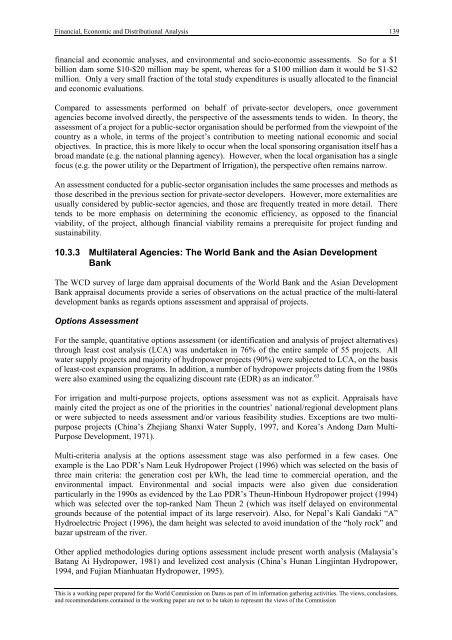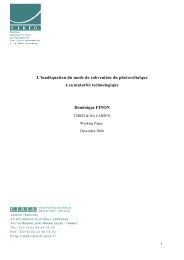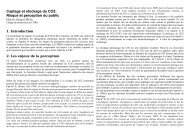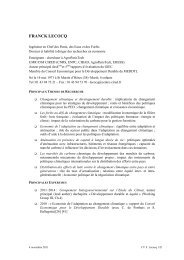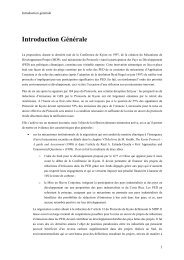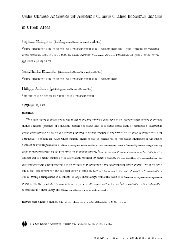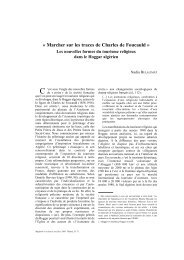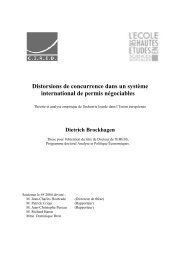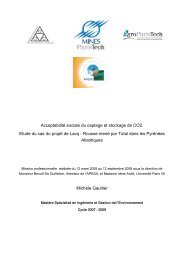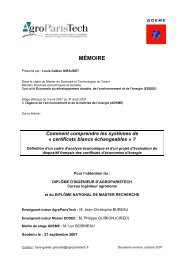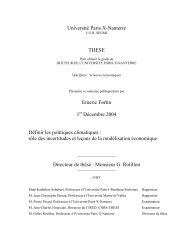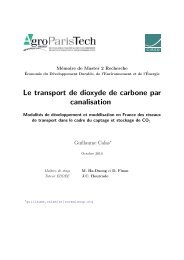Financial, Economic and Distributional Analysis - Centre ...
Financial, Economic and Distributional Analysis - Centre ...
Financial, Economic and Distributional Analysis - Centre ...
Create successful ePaper yourself
Turn your PDF publications into a flip-book with our unique Google optimized e-Paper software.
<strong>Financial</strong>, <strong>Economic</strong> <strong>and</strong> <strong>Distributional</strong> <strong>Analysis</strong> 139financial <strong>and</strong> economic analyses, <strong>and</strong> environmental <strong>and</strong> socio-economic assessments. So for a $1billion dam some $10-$20 million may be spent, whereas for a $100 million dam it would be $1-$2million. Only a very small fraction of the total study expenditures is usually allocated to the financial<strong>and</strong> economic evaluations.Compared to assessments performed on behalf of private-sector developers, once governmentagencies become involved directly, the perspective of the assessments tends to widen. In theory, theassessment of a project for a public-sector organisation should be performed from the viewpoint of thecountry as a whole, in terms of the project’s contribution to meeting national economic <strong>and</strong> socialobjectives. In practice, this is more likely to occur when the local sponsoring organisation itself has abroad m<strong>and</strong>ate (e.g. the national planning agency). However, when the local organisation has a singlefocus (e.g. the power utility or the Department of Irrigation), the perspective often remains narrow.An assessment conducted for a public-sector organisation includes the same processes <strong>and</strong> methods asthose described in the previous section for private-sector developers. However, more externalities areusually considered by public-sector agencies, <strong>and</strong> those are frequently treated in more detail. Theretends to be more emphasis on determining the economic efficiency, as opposed to the financialviability, of the project, although financial viability remains a prerequisite for project funding <strong>and</strong>sustainability.10.3.3 Multilateral Agencies: The World Bank <strong>and</strong> the Asian DevelopmentBankThe WCD survey of large dam appraisal documents of the World Bank <strong>and</strong> the Asian DevelopmentBank appraisal documents provide a series of observations on the actual practice of the multi-lateraldevelopment banks as regards options assessment <strong>and</strong> appraisal of projects.Options AssessmentFor the sample, quantitative options assessment (or identification <strong>and</strong> analysis of project alternatives)through least cost analysis (LCA) was undertaken in 76% of the entire sample of 55 projects. Allwater supply projects <strong>and</strong> majority of hydropower projects (90%) were subjected to LCA, on the basisof least-cost expansion programs. In addition, a number of hydropower projects dating from the 1980swere also examined using the equalizing discount rate (EDR) as an indicator. 63For irrigation <strong>and</strong> multi-purpose projects, options assessment was not as explicit. Appraisals havemainly cited the project as one of the priorities in the countries’ national/regional development plansor were subjected to needs assessment <strong>and</strong>/or various feasibility studies. Exceptions are two multipurposeprojects (China’s Zhejiang Shanxi Water Supply, 1997, <strong>and</strong> Korea’s Andong Dam Multi-Purpose Development, 1971).Multi-criteria analysis at the options assessment stage was also performed in a few cases. Oneexample is the Lao PDR’s Nam Leuk Hydropower Project (1996) which was selected on the basis ofthree main criteria: the generation cost per kWh, the lead time to commercial operation, <strong>and</strong> theenvironmental impact. Environmental <strong>and</strong> social impacts were also given due considerationparticularly in the 1990s as evidenced by the Lao PDR’s Theun-Hinboun Hydropower project (1994)which was selected over the top-ranked Nam Theun 2 (which was itself delayed on environmentalgrounds because of the potential impact of its large reservoir). Also, for Nepal’s Kali G<strong>and</strong>aki “A”Hydroelectric Project (1996), the dam height was selected to avoid inundation of the “holy rock” <strong>and</strong>bazar upstream of the river.Other applied methodologies during options assessment include present worth analysis (Malaysia’sBatang Ai Hydropower, 1981) <strong>and</strong> levelized cost analysis (China’s Hunan Lingjintan Hydropower,1994, <strong>and</strong> Fujian Mianhuatan Hydropower, 1995).This is a working paper prepared for the World Commission on Dams as part of its information gathering activities. The views, conclusions,<strong>and</strong> recommendations contained in the working paper are not to be taken to represent the views of the Commission


